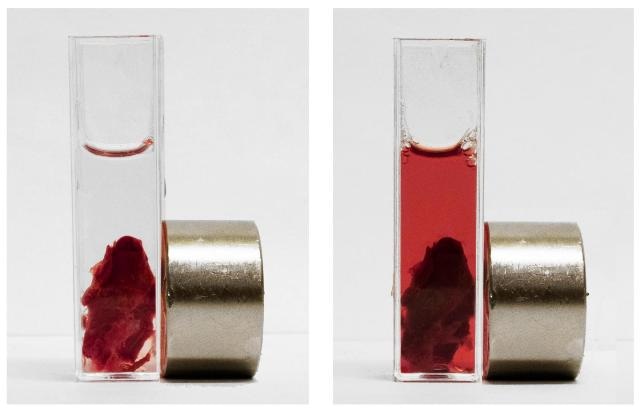Jun 24 2016
One of the primary health concerns worldwide are the critical conditions caused by the blockage of blood vessels. The main aim for emergency assistance during the onset of such conditions is to efficiently implement thrombolysis - dissolving the clot quickly. ITMO University researchers in collaboration with Mariinsky Hospital in Saint Petersburg have created a magnetically controlled drug that could condense on a blood clot due to the presence of a magnetic field.
 The influence of developed thrombolytic system on vascular thrombus extracted during the operation. (Credit- ITMO University)
The influence of developed thrombolytic system on vascular thrombus extracted during the operation. (Credit- ITMO University)
This novel drug is harmless as an intravenous injection and could dissolve clots up 4000 times more effectively than conventional enzyme-based drugs. The recent research would also help in the reduction of drug dosage, avoiding a number of side effects. The findings of the study were reported in Scientific Reports.
In thrombosis, during emergency situations, the clot should be destroyed within a very short span of time, of about 3 to 5 hours. After this the tissues die due to the absence of blood flow. Even if the patient undergoes thrombolysis, they would encounter a number of complications caused due to the thrombolytic drug, which is a specific enzyme injected intravenously for dissolving the blood clots. In developed countries, on an average, thrombolysis is successfully carried out in 15% of the patients. The figure is much lower in countries like Russia, where only two out of 100 patients brought to the hospital can benefit from the procedure. The patient encounters the risk of disability of death in all the other cases.
The drawback of thrombolytic drugs is that they do not target the clot, but instead spread over the entire circulatory system. The organism blocks a foreign enzyme, reducing its activity rapidly. The drugs are injected in knock-out doses so that at least a little portion will reach the blood clot at the correct time.
Now we are using a sledge-hammer to crack a nut. Dissolving a little blood clot that blocked a vessel of only 1-2 mm in diameter, thrombolytic drugs negatively affect the entire network of blood vessels. In order to change the situation, we decided to develop a method of targeted drug delivery that would allow us to considerably reduce the dosage and ensure that the whole therapeutic effect is focused on the clot.
Ivan Dudanov, Head of the Regional Cardiovascular Center, Mariinsky Hospital
The researchers made a composite material, which could transport thrombolytic enzymes in a harmless and specific manner. The new material contains a porous magnetite framework and urokinase molecules. Urokinase is an enzyme commonly used as a thrombolytic agent in medicine. The composite could be used to form thrombolytic coating in artificial blood vessels and stable injectable solutions composed of nanosized particles that could be localized near the clot easily with the help of an external magnetic field.
The magnetite framework protects enzymes against different inhibitors present in the blood and can neutralize thrombolytic medications.
Usually, in order to achieve a prolonged effect for such drugs, the enzyme is placed inside a polymeric matrix. The enzyme is then gradually released from the matrix and eventually looses all activity. We, on the other hand, experimentally demonstrated that enzymes protected using our approach do not lose therapeutic properties over extended periods of time and even after repeated use. The rate, at which the new drug can dissolve the clot outperforms unprotected enzymes by about 4000 times.
Andrey Drozdov, Researcher, Laboratory of Solution Chemistry of Advanced Materials and Technologies
Since the material constitutes components that have permission for intravenous injection, it is potentially safe for humans. Professor Dudanov suggests that future drugs based on the new composite can be used for thrombosis treatment and prevention. The enzyme is capable of gently cleaning the vessels and would remain active for very long till it is excreted by the liver similar to an ordinary metabolite, even though it circulates in small amounts in the blood.
This research turned out to become a logical extension of previous studies involving enzyme entrapment into sol-gel magnetite matrix and the construction of magnetically controlled bioactive systems.
In this phase of our project, we have demonstrated how the concept we developed works for more specific objects. We prepared a thrombolytic colloid and tested its effects on an artificial blood clots obtained from plasma and blood of humans, and thrombus extracted from patients. The results may soon allow us to try out the new thrombolytic system on mammals. Now we are preparing for preclinical studies.
Vladimir Vinogradov, Head of the Laboratory of Solution Chemistry of Advanced Materials and Technologies